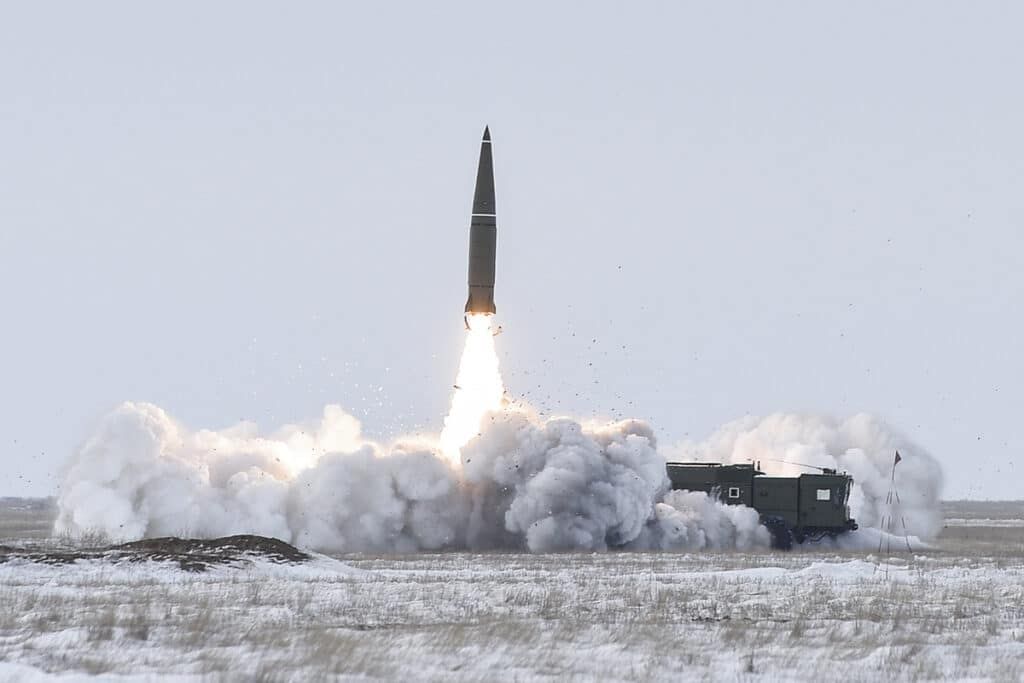Rhetoric in Ukraine has reinforced the fallacy of limited nuclear exchange
By John Gower, Andrew Weber | October 21, 2022
 A launch of the Russian Iskander-M, which can carry a tactical nuclear warhead, at the Kapustin Yar proving ground in March 2018. Photo credit: the websites (mil.ru, минобороны.рф) of the Ministry of Defence of the Russian Federation.
Licensed under the Creative Commons Attribution 4.0.
A launch of the Russian Iskander-M, which can carry a tactical nuclear warhead, at the Kapustin Yar proving ground in March 2018. Photo credit: the websites (mil.ru, минобороны.рф) of the Ministry of Defence of the Russian Federation.
Licensed under the Creative Commons Attribution 4.0.
Since the end of the Cold War, Russia, the United States, France, and China have continued to possess and develop nuclear weapons below the strategic level of land-based and submarine-launched intercontinental-range ballistic missiles. The long-touted rationale for this was simple: non-strategic (or tactical) nuclear weapons are necessary to give the decision-maker more options and provide a credible proportionate deterrence response to the use of similar weapons by an adversary.
The rationale continues by implying that such nuclear weapons use would occupy a third and separate strategic conflict space between conventional war and all-out strategic nuclear exchange. It is necessary, it has been argued, to occupy that space to deter at all levels.
The profound implication of this line of reasoning is that this “limited nuclear exchange” space is both distinct and separate from conventional war below and nuclear Armageddon above, and that transitions between the spaces can be controlled. This is at best unproven conjecture.
For many years, opponents to the continued existence of such tactical weapons in nuclear arsenals—including these authors—have argued to the contrary. Rather than being controlled, these transitions are simultaneously enabled, increased in probability, and accelerated by the very existence of such weapons.
Russia’s invasion of Ukraine, with Russian President Vladimir Putin’s attendant and near-continuous rattling of his nuclear saber, has brought this argument—previously restricted to academic debates, policy desks, and war games—to stark reality.
His first threats, as the war unfolded, were largely—and rightly so—ignored by Western nuclear-armed nations: the US President did not want to “nuclearize” what is still a conventional conflict. Six months into the war and in the face of Russian conventional losses and retreats, Putin has doubled down and made more specific threats.
While some commentators interpret Putin’s remarks as something less than an increased threat, that is not consistent with his other moves: non-elections in the seized regions, sabotage of the North Sea pipeline, increased use of indiscriminate drone attacks, the appointment of a proven hard man in charge, and a mass mobilization. Even if this rather apologist view turns out to be correct, getting the response rhetoric right is a vital element of preventing a dangerous escalation.
The only good news is that Putin does not yet appear to be making concrete steps to turn his bellicose rhetoric into preparations for nuclear weapon use, such as preparing to draw warheads from storage and mate them with their delivery systems.
According to current US and NATO countries’ nuclear doctrines, the response to Putin’s escalatory rhetoric should have been carefully calibrated proportional rhetoric: it should have reminded Putin that a transition by Russia from the conventional space to the less-than-strategic nuclear space would be met with a range of options that include a proportional nuclear response. Indeed, the rationale by those maintaining tactical nuclear weapons has long been that threats of massive retaliation are simply not credible.
But that’s not what happened.
President Putin operates largely in an unchallenged one-man power space, which the UK’s communications intelligence agency GCHQ opines is largely responsible for Russia’s strategic failures, and therefore has little moderation on his choice of rhetoric. In contrast, any nuclear rhetoric by the United States and other NATO nuclear powers has been carefully calibrated instead. Thus, any variation from declaratory doctrine will not be accidental and deserves close scrutiny.
The stark assessment that tactical nuclear weapons may actually be used by Russia in Ukraine has clearly broken the “limited exchange” theory around the table of the US President’s National Security Council. The National Security Advisor, Jake Sullivan, did not use proportional language, nor subsequently did President Biden.
On September 25, Sullivan stated: “We have communicated directly, privately and at very high levels to the Kremlin that any use of nuclear weapons will be met with catastrophic consequences for Russia, that the US and our allies will respond decisively, and we have been clear and specific about what that will entail.” On October 6, during a fund-raiser in New York, President Biden said, “We have not faced the prospect of Armageddon since Kennedy and the Cuban missile crisis.”
Words like “Armageddon” and “catastrophic” are dramatic, are not proportional, and certainly were carefully chosen.
With its choice of words, the National Security Council seems to have accepted that the transition into nuclear weapons use in the 21st century is something untried and that escalation control—far from assured—is nebulous and likely mythical, as James Acton, an analyst at the Carnegie Endowment for International Peace explained in a series of tweets following Biden’s “Armageddon” comment.
Such declarations illustrate an understanding at the highest level of the need to deter any nuclear weapon employment with the threat of a catastrophic response.
Perhaps realizing the hollowness of the like-for-like limited exchange shibboleth, siren voices have begun to weave a parallel new construct, that Western countries (or NATO—largely undefined) could respond to the first use of a nuclear weapon in war since 1945 through a “devastating” conventional response. This novelty is meant to avoid the nuclear escalation their limited exchange theories were certain could be controlled. This is, however, its own equally dangerous fantasy.
A conventional response to Russian nuclear use would need to be so devastating that it would likely provoke further nuclear use. This is particularly true if this response involved, as General Petraeus suggested in an interview on October 2, “[the United States] leading a NATO, a collective effort, that would take out every Russian conventional force that we can see and identify on the battlefield in Ukraine and also in Crimea and every ship in the Black Sea.” Such a second nuclear use in response would likely be aimed at those who destroyed his conventional forces – NATO – rather than be confined to Ukraine.
Indeed, if there were no nuclear response, the whole tapestry of nuclear deterrence across the world could unravel dangerously. This dilemma—how to respond to a limited nuclear use—has dogged every secret wargame since the turning of the millennium. It enabled the continued possession of tactical nuclear weapons and mindsets long past their Cold War best-before date. Such narrative invented a “more acceptable” use of nuclear weapons as a brief nuclear excursion in a conventional war. The mindsets bred a generation of officers and officials who accepted this notion and integrated limited nuclear use and “off-ramps” into their rhetoric and war plans.
But this dilemma is based on false premises. The way to deter the transition to a likely uncontrolled nuclear escalation is to make it clear that a devastating response would ensue to any nuclear weapon employment. Clear blue water needs to be re-established and maintained between conventional conflict and any nuclear weapon attack.
The national security advisor to the president of the United States now clearly understands this, as does his president. Let’s just hope that President Putin, despite his rhetoric, also understands it.
Hope alone is not a strategy. We must bolster hope with urgent action to remove these less-than-strategic weapons, whose existence has brought us to this febrile place and has been shown to be illusionary and dangerously destabilizing.
Together, we make the world safer.
The Bulletin elevates expert voices above the noise. But as an independent nonprofit organization, our operations depend on the support of readers like you. Help us continue to deliver quality journalism that holds leaders accountable. Your support of our work at any level is important. In return, we promise our coverage will be understandable, influential, vigilant, solution-oriented, and fair-minded. Together we can make a difference.

















I think that the largest factor is that the youth have been fed a load of bogus claims about climate change and ; now they’re too ignorant to analyze a real threat when they may be facing one.
I wish we didn’t have low yield nukes. I wish, instead of upgrading for $1.3 trillion over the next 9 years all 3.500 of our active nukes, we upgraded only -what ? 50?. Just think of all the universal healthcare (Liberal) or tax cuts for billionaires (Conservative) you could have. Also, if/when nukes are completely off the table, the $ spent to achieve/continue free republics would be much lower, reducing taxes, or re-allocating them, as you want. Lakes and rivers are drying up Brian, historic Lowes across the globe, consistent with the $ of global warming. Your grandchildren will live… Read more »
Ominously there is very little talk about nuclear deterrence these days. May be because the theory is obsolete: the scenarios in which nukes will be used are unfolding, uncontrollably. As history shows, every empire eventually faces the war it wants to avoid. Nuclear war included it would seem.
https://patternofhistory.wordpress.com/
This is unfortunately one of the most one-sided descriptions of Russia’s actions over the last motnh’s I have seen from any anti-war organization. Russia has at two occasions on continuing dates mentioned nuclear weapons over the last six motnhs, and the west talks everyday as if nuclear war is winnable. Russia’s only comments as of the last months on nuclear weapons was two or three sentences in a long speech by Putin where he established that according to standard Russian nuclear doctrine, the annexed terriotores of course could be defended by nuclear weapons, and then we have a second single… Read more »
they need to make this on a nutshell for younger people, nobody in this day and age will read this much, maybe on a video of some sorts
Thank you for this feedback. Andy and I will look at this. We have done video podcasts on these issues before
This briefer was primarily aimed at decision makers.